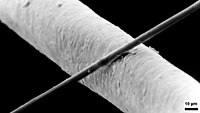
Photo from wikipedia
Abstract Compared to the classical Rayleigh-Ritz method and other analytical solutions, finite element (FE) method is more efficient and capable in calculating the deformations and stress states of partial-interaction composite… Click to show full abstract
Abstract Compared to the classical Rayleigh-Ritz method and other analytical solutions, finite element (FE) method is more efficient and capable in calculating the deformations and stress states of partial-interaction composite beams, as well as manipulating the material and geometrical parameters for better engineering designs. Stiffness matrix of composite beams considering the interlayer slips is derived based on the kinematic assumptions of the Timoshenko’s beam theory by taking into account of the transverse shear deformations. A detailed derivation is elaborated to obtain the local stiffness matrix for a composite beam element, while the higher-order interpolation functions are adopted for the displacement fields (deflection, rotation, and interlayer slip). Then a finite element program is developed by assembling the local stiffness matrices and applying corresponding equivalent nodal stresses. Several numerical results are presented and compared against the analytical solutions available in the literature to demonstrate the accuracy of the proposed FE stiffness matrix. Finally, a design procedure by connecting particle swarm optimization technique with the present FE analysis is created to reduce the deformations of simply supported composite beams while the quantity of shear connectors remains the same, to prove the superior simulation capacity and efficiency of the derived FE stiffness matrix with other techniques. Compared to the analytical methods, the proposed finite element is more convenient and applicable in the analysis of partial-interaction composite beams under more complicated loading and boundary conditions. In the meantime, the explicitly expressed local stiffness matrix can be easily implemented into other commercial software packages as a subroutine for both professional and personal engineering designs and calculations.
Journal Title: Construction and Building Materials
Year Published: 2017
Link to full text (if available)
Share on Social Media: Sign Up to like & get
recommendations!